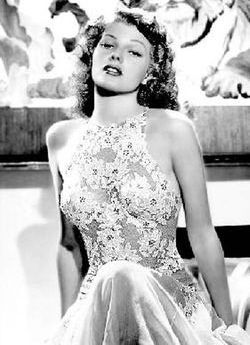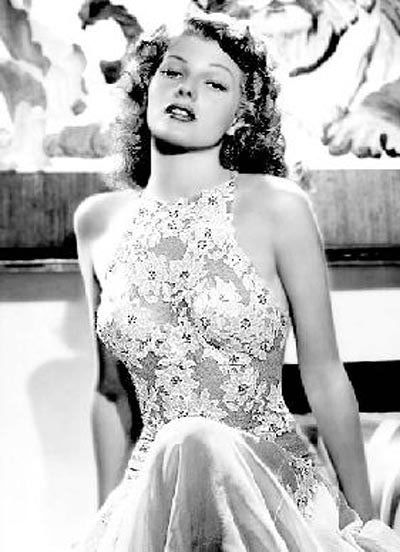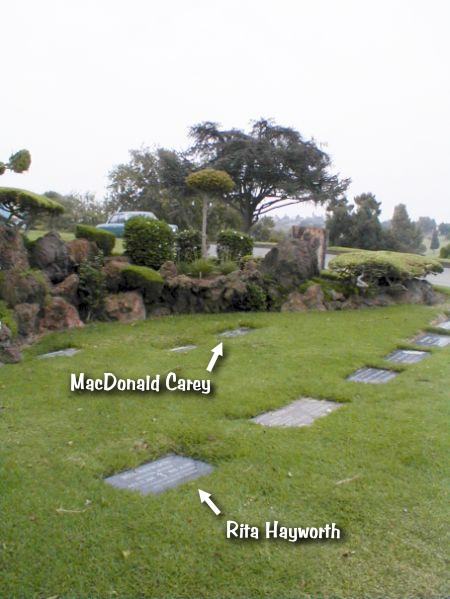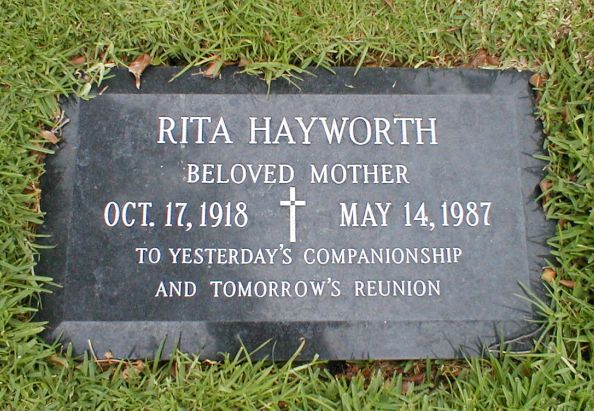Actress, Dancer. She achieved fame during the 1940s as one of Hollywood's top stars, appearing in 18 movies during that era. Born Margarita Carmen Cansino, her father was a Spanish immigrant and her mother was of Irish-English stock who had performed with the Ziegfeld Follies. Taught dancing at an early age by her uncle, she started performing publicly at the age of six. In 1926 at the age of eight, she was featured in "La Fiesta," a short Warner Brothers film. The following year, her father moved the family to Hollywood, California, with the hope that dancing could be featured in the movies and that his family could be part of it. He established his own dance studio, where he taught such Hollywood luminaries as James Cagney and Jean Harlow. During the Great Depression, he lost all his investments, as musicals were no longer trendy and commercial interest in his dancing classes waned. He partnered with her to form "The Dancing Cansinos", however, California law prevented her from working in bars and nightclubs because of her age, and her father took her with him to work across the border in Tijuana, Mexico as it was a popular tourist spot for people from Los Angeles, California. Due to her working, she never finished high school. At the age of 16, she took a bit part in the film "Cruz Diablo" (1934) which led to another in "In Caliente" (1935) with the Mexican actress, Dolores del Río. When Winfield Sheehan, the head of the Fox Film Corporation, saw her dancing at the Caliente Club, he arranged for her to do a screen test a week later. Impressed by her screen persona, she was signed her for a short-term six-month contract at Fox, under the name Rita Cansino, the first of two name changes for her film career. While at Fox, she appeared in five pictures in non-notable roles. By the end of her six-month contract, Fox had merged into 20th Century Fox, with Darryl F. Zanuck serving as the executive producer. Dismissing Sheehan's interest in her, Zanuck did not renew her contract. Feeling that she had screen potential, the salesman and promoter, Edward C. Judson, whom she would marry in 1936, got her the lead roles in several independent films and arranged a screen test with Columbia Pictures. The studio head Harry Cohn signed Hayworth to a long-term contract, and cast her in small roles in Columbia features. In 1935 she appeared in "Dante's Inferno" with Spencer Tracy, "Paddy O'Day", "Under the Pampas Moon", and "Charlie Chan in Egypt". In 1936, she took her first starring role as a 'Latin type' in "Human Cargo." However. Cohn believed that her image was too Mediterranean, which reduced her opportunities to being cast in "exotic" roles, more limited in number. With Cohn and Judson's encouragement, she changed her hair color to dark red and her name to Rita Hayworth. By using her mother's maiden name, she led people to see her British-American ancestry and became a classic "American" pin-up. In 1937 she appeared in five minor Columbia pictures and three independent movies and the following year she appeared in five Columbia B-movies. In 1939 Cohn convinced director Howard Hawks to use her for a small but important role as a man-trap in the aviation drama "Only Angels Have Wings," in which she played opposite Cary Grant and Jean Arthur, and it put her on the road to success. The following year, she appeared in "Music in My Heart", "The Lady in Question", and "Angels Over Broadway". She was loaned to Metro-Goldwyn-Mayer studios to appear in "Susan and God" opposite Joan Crawford. While on loan to Warner Brothers, she appeared as the second female lead in "The Strawberry Blonde" (1941) opposite James Cagney and Olivia de Havilland. As the film was a big box-office success, her popularity began to rise and she became one of Hollywood's hottest properties. So impressed was Warner Brothers that they tried to buy her contract from Columbia, but Cohn refused. Her success led to a notable supporting role as the seductive 'Dona Sol des Muire' in "Blood and Sand" (1941) opposite Tyrone Power and Linda Darnell. Returning to Columbia Pictures, she was cast in the musical "You'll Never Get Rich" (1941) opposite Fred Astaire in one of the highest-budgeted films Columbia had ever made. The picture was so successful that the following year the studio produced and released another Astaire-Hayworth picture, "You Were Never Lovelier". In 1942 she also appeared in two other pictures, "Tales of Manhattan" and "My Gal Sal." The same year, she divorced Edward C. Judson and married Orson Welles a year later. In 1944 she made one of her best-known films, the Technicolor musical "Cover Girl" with Gene Kelly, which established her as Columbia's top star of the 1940s. For three consecutive years, starting in 1944, she was named one of the top movie box office attractions in the world. She continued with "Tonight and Every Night" (1945, with Lee Bowman) and "Down to Earth" (1947, with Larry Parks). Her erotic appeal was most noted in Charles Vidor's black and white film noir "Gilda" (1946, with Glenn Ford), which caused censors some consternation. The role, in which she wore black satin and performed a legendary one-glove striptease, made her into a cultural icon as a mysterious and seductive woman. This was followed with "The Lady from Shanghai," directed by Orson Welles, was critically acclaimed. The film's failure at the box office was attributed in part to Welles having had her famous red hair cut short and dyed platinum blonde for the role. She was featured in a Life magazine cover story, which led to her nickname as "The Love Goddess". Her next film, "The Loves of Carmen" (1948, with Glenn Ford), was the first film co-produced by Columbia and her production company, The Beckworth Corporation and it was Columbia's biggest moneymaker that year. She received a percentage of the profits from this and all her subsequent films until 1954, when she dissolved Beckworth to pay off debts. In 1948 she traveled to Cannes and was introduced to Prince Aly Khan, a Pakistani by nationality, and son of Sultan Mahommed Shah, Aga Khan III, the leader of the Ismaili sect of Shia Islam, and they began a year-long courtship, which received enormous world press coverage. Because she was still legally married to Orson Welles (they finally divorced later in 1948), she received some negative backlash for her courtship with the prince, causing some American fans to boycott her pictures. They were married in May 1949, marking the first time a Hollywood actress became a princess. She then left Hollywood and moved to France, breaking her contract with Columbia. Although she was anxious to start a new life abroad, Khan's flamboyant lifestyle and duties proved too difficult for her. She did not get along with his friends, and she struggled to learn French. Khan was also known in circles as a playboy, and it was suspected that he had been unfaithful to her during the marriage. In 1951 she relocated to New York City, New York and they were finally divorced in 1953. She returned to Hollywood and starred in her "comeback" film, the highly publicized "Affair in Trinidad" (1952, with Glenn Ford). In 1953 she was featured in two films, "Salome" with Charles Laughton and Stewart Granger, and "Miss Sadie Thompson" with José Ferrer and Aldo Ray, which won her critical acclaim. For the next four years, she did not make a film appearance, due mainly to a tumultuous marriage to the singer Dick Haymes, whom she married in 1953. During her marriage to Haymes, she was involved in much negative publicity, due to his physical abuse and lawsuits with his previous wives which significantly lessened her appeal, and she divorced him in 1955. By the time she returned to the screen for "Fire Down Below" (1957, with Robert Mitchum and Jack Lemmon) she had been replaced by Kim Novak as Columbia's top female star. Her last musical was "Pal Joey" (1957, with Frank Sinatra and Kim Novak), after which she parted ways with Columbia Pictures. She received good reviews in "Separate Tables" (1958, with Burt Lancaster and David Niven), and "The Story on Page One" (1960, with Anthony Franciosa). In 1958 she married film producer James Hill but divorced in 1961. In 1962 her planned Broadway debut in "Step on a Crack" was cancelled for undisclosed health reasons. She made a well-publicized 1971 television appearance on The Carol Burnett Show. Her last film was "The Wrath of God" (1972). By this time, her physical and mental health began to deteriorate, which became evident in the filming of "The Wrath of God, as she could not remember her lines and they had to film her scenes one line at a time. In 1973 she agreed to do one more movie, the British "Tales That Witness Madness" but due to worsening health, she abandoned the movie set, and returned to the US, never to return to acting. She struggled with alcohol throughout her life and her alcoholism hid symptoms of what was eventually understood to be Alzheimer's disease, which she was diagnosed in 1980. In July 1981 her health had deteriorated to the point where a judge ruled that she should be placed under the care of her daughter, Yasmin Khan of New York City. She lived in an apartment next to her daughter, who arranged for care for her mother through her final years. In February 1987 she lapsed into a semi coma and died from Alzheimer's disease a few months later at the age of 68. During her career, she appeared in over 60 films, some in uncredited roles and some credited as Rita Casino. She is one of six women who have the distinction of having danced on screen with both Fred Astaire and Gene Kelly. In 1964 she received a Golden Globe nomination Best Actress in a Motion Picture Drama in "Circus World" and in 1977 she received a National Screen Heritage Award. In 1983 actress Lynda Carter portrayed her in the television movie "Rita Hayworth: The Love Goddess." She has a star on the Hollywood Walk of Fame and is listed by the American Film Institute as one of the 100 Greatest Stars of All Time.
Actress, Dancer. She achieved fame during the 1940s as one of Hollywood's top stars, appearing in 18 movies during that era. Born Margarita Carmen Cansino, her father was a Spanish immigrant and her mother was of Irish-English stock who had performed with the Ziegfeld Follies. Taught dancing at an early age by her uncle, she started performing publicly at the age of six. In 1926 at the age of eight, she was featured in "La Fiesta," a short Warner Brothers film. The following year, her father moved the family to Hollywood, California, with the hope that dancing could be featured in the movies and that his family could be part of it. He established his own dance studio, where he taught such Hollywood luminaries as James Cagney and Jean Harlow. During the Great Depression, he lost all his investments, as musicals were no longer trendy and commercial interest in his dancing classes waned. He partnered with her to form "The Dancing Cansinos", however, California law prevented her from working in bars and nightclubs because of her age, and her father took her with him to work across the border in Tijuana, Mexico as it was a popular tourist spot for people from Los Angeles, California. Due to her working, she never finished high school. At the age of 16, she took a bit part in the film "Cruz Diablo" (1934) which led to another in "In Caliente" (1935) with the Mexican actress, Dolores del Río. When Winfield Sheehan, the head of the Fox Film Corporation, saw her dancing at the Caliente Club, he arranged for her to do a screen test a week later. Impressed by her screen persona, she was signed her for a short-term six-month contract at Fox, under the name Rita Cansino, the first of two name changes for her film career. While at Fox, she appeared in five pictures in non-notable roles. By the end of her six-month contract, Fox had merged into 20th Century Fox, with Darryl F. Zanuck serving as the executive producer. Dismissing Sheehan's interest in her, Zanuck did not renew her contract. Feeling that she had screen potential, the salesman and promoter, Edward C. Judson, whom she would marry in 1936, got her the lead roles in several independent films and arranged a screen test with Columbia Pictures. The studio head Harry Cohn signed Hayworth to a long-term contract, and cast her in small roles in Columbia features. In 1935 she appeared in "Dante's Inferno" with Spencer Tracy, "Paddy O'Day", "Under the Pampas Moon", and "Charlie Chan in Egypt". In 1936, she took her first starring role as a 'Latin type' in "Human Cargo." However. Cohn believed that her image was too Mediterranean, which reduced her opportunities to being cast in "exotic" roles, more limited in number. With Cohn and Judson's encouragement, she changed her hair color to dark red and her name to Rita Hayworth. By using her mother's maiden name, she led people to see her British-American ancestry and became a classic "American" pin-up. In 1937 she appeared in five minor Columbia pictures and three independent movies and the following year she appeared in five Columbia B-movies. In 1939 Cohn convinced director Howard Hawks to use her for a small but important role as a man-trap in the aviation drama "Only Angels Have Wings," in which she played opposite Cary Grant and Jean Arthur, and it put her on the road to success. The following year, she appeared in "Music in My Heart", "The Lady in Question", and "Angels Over Broadway". She was loaned to Metro-Goldwyn-Mayer studios to appear in "Susan and God" opposite Joan Crawford. While on loan to Warner Brothers, she appeared as the second female lead in "The Strawberry Blonde" (1941) opposite James Cagney and Olivia de Havilland. As the film was a big box-office success, her popularity began to rise and she became one of Hollywood's hottest properties. So impressed was Warner Brothers that they tried to buy her contract from Columbia, but Cohn refused. Her success led to a notable supporting role as the seductive 'Dona Sol des Muire' in "Blood and Sand" (1941) opposite Tyrone Power and Linda Darnell. Returning to Columbia Pictures, she was cast in the musical "You'll Never Get Rich" (1941) opposite Fred Astaire in one of the highest-budgeted films Columbia had ever made. The picture was so successful that the following year the studio produced and released another Astaire-Hayworth picture, "You Were Never Lovelier". In 1942 she also appeared in two other pictures, "Tales of Manhattan" and "My Gal Sal." The same year, she divorced Edward C. Judson and married Orson Welles a year later. In 1944 she made one of her best-known films, the Technicolor musical "Cover Girl" with Gene Kelly, which established her as Columbia's top star of the 1940s. For three consecutive years, starting in 1944, she was named one of the top movie box office attractions in the world. She continued with "Tonight and Every Night" (1945, with Lee Bowman) and "Down to Earth" (1947, with Larry Parks). Her erotic appeal was most noted in Charles Vidor's black and white film noir "Gilda" (1946, with Glenn Ford), which caused censors some consternation. The role, in which she wore black satin and performed a legendary one-glove striptease, made her into a cultural icon as a mysterious and seductive woman. This was followed with "The Lady from Shanghai," directed by Orson Welles, was critically acclaimed. The film's failure at the box office was attributed in part to Welles having had her famous red hair cut short and dyed platinum blonde for the role. She was featured in a Life magazine cover story, which led to her nickname as "The Love Goddess". Her next film, "The Loves of Carmen" (1948, with Glenn Ford), was the first film co-produced by Columbia and her production company, The Beckworth Corporation and it was Columbia's biggest moneymaker that year. She received a percentage of the profits from this and all her subsequent films until 1954, when she dissolved Beckworth to pay off debts. In 1948 she traveled to Cannes and was introduced to Prince Aly Khan, a Pakistani by nationality, and son of Sultan Mahommed Shah, Aga Khan III, the leader of the Ismaili sect of Shia Islam, and they began a year-long courtship, which received enormous world press coverage. Because she was still legally married to Orson Welles (they finally divorced later in 1948), she received some negative backlash for her courtship with the prince, causing some American fans to boycott her pictures. They were married in May 1949, marking the first time a Hollywood actress became a princess. She then left Hollywood and moved to France, breaking her contract with Columbia. Although she was anxious to start a new life abroad, Khan's flamboyant lifestyle and duties proved too difficult for her. She did not get along with his friends, and she struggled to learn French. Khan was also known in circles as a playboy, and it was suspected that he had been unfaithful to her during the marriage. In 1951 she relocated to New York City, New York and they were finally divorced in 1953. She returned to Hollywood and starred in her "comeback" film, the highly publicized "Affair in Trinidad" (1952, with Glenn Ford). In 1953 she was featured in two films, "Salome" with Charles Laughton and Stewart Granger, and "Miss Sadie Thompson" with José Ferrer and Aldo Ray, which won her critical acclaim. For the next four years, she did not make a film appearance, due mainly to a tumultuous marriage to the singer Dick Haymes, whom she married in 1953. During her marriage to Haymes, she was involved in much negative publicity, due to his physical abuse and lawsuits with his previous wives which significantly lessened her appeal, and she divorced him in 1955. By the time she returned to the screen for "Fire Down Below" (1957, with Robert Mitchum and Jack Lemmon) she had been replaced by Kim Novak as Columbia's top female star. Her last musical was "Pal Joey" (1957, with Frank Sinatra and Kim Novak), after which she parted ways with Columbia Pictures. She received good reviews in "Separate Tables" (1958, with Burt Lancaster and David Niven), and "The Story on Page One" (1960, with Anthony Franciosa). In 1958 she married film producer James Hill but divorced in 1961. In 1962 her planned Broadway debut in "Step on a Crack" was cancelled for undisclosed health reasons. She made a well-publicized 1971 television appearance on The Carol Burnett Show. Her last film was "The Wrath of God" (1972). By this time, her physical and mental health began to deteriorate, which became evident in the filming of "The Wrath of God, as she could not remember her lines and they had to film her scenes one line at a time. In 1973 she agreed to do one more movie, the British "Tales That Witness Madness" but due to worsening health, she abandoned the movie set, and returned to the US, never to return to acting. She struggled with alcohol throughout her life and her alcoholism hid symptoms of what was eventually understood to be Alzheimer's disease, which she was diagnosed in 1980. In July 1981 her health had deteriorated to the point where a judge ruled that she should be placed under the care of her daughter, Yasmin Khan of New York City. She lived in an apartment next to her daughter, who arranged for care for her mother through her final years. In February 1987 she lapsed into a semi coma and died from Alzheimer's disease a few months later at the age of 68. During her career, she appeared in over 60 films, some in uncredited roles and some credited as Rita Casino. She is one of six women who have the distinction of having danced on screen with both Fred Astaire and Gene Kelly. In 1964 she received a Golden Globe nomination Best Actress in a Motion Picture Drama in "Circus World" and in 1977 she received a National Screen Heritage Award. In 1983 actress Lynda Carter portrayed her in the television movie "Rita Hayworth: The Love Goddess." She has a star on the Hollywood Walk of Fame and is listed by the American Film Institute as one of the 100 Greatest Stars of All Time.
Bio by: William Bjornstad
Inscription
Rita Hayworth
Beloved Mother
Oct. 17, 1918 † May 14, 1987
To Yesterday's Companionship
And Tomorrow's Reunion
Family Members
Advertisement















